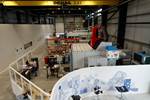NASA and Blue Origin partner to test new technologies in space
Blue Origin will fly technology payloads in space on its New Shepard suborbital spacecraft.
Blue Origin, the private spaceflight company of Amazon founder Jeff Bezos, will work with NASA to transport new technologies near the boundary of space as part of the agency’s Flight Opportunities Program. Blue Origin has a test facility located north of Van Horn, Texas.
Under this indefinite-delivery, indefinite-quantity contract, Blue Origin will fly technology payloads in space on its New Shepard suborbital spacecraft.
“We are pleased to have Blue Origin join our cadre of Flight Opportunities service providers,” said Steve Jurczyk, associate administrator for NASA’s Space Technology Mission Directorate (STMD) in Washington. “Adding additional flight providers enables NASA and the broader aerospace community to demonstrate and transition space technologies, developing new capabilities faster and, potentially, at lower cost.”
This contract is a continuation of contracts awarded in 2014 and 2015, providing commercial capabilities using proven flight systems. The contract allows for ramping on of new vendors and the addition of new flight profiles on at least an annual basis, as determined by the government’s requirements.
Blue Origin will join the following firms currently under contract:
Masten Space Systems Inc., Mojave, Calif.
Near Space Corp., Tillamook, Ore.
UP Aerospace Inc., Littleton, Colo.
Virgin Galactic, New York
World View Enterprises, Tucson, Ariz.
Through the Flight Opportunities Program, STMD selects promising technologies from industry, academia and government, and tests them on commercial launch vehicles. The Flight Opportunities Program is funded by STMD, and managed at NASA's Armstrong Flight Research Center in Edwards, Calif. STMD is responsible for developing the crosscutting, pioneering, new technologies and capabilities needed by the agency to achieve its current and future missions.
Related Content
-
Hybrid process marries continuous, discontinuous composites design
9T Labs and Purdue applied Additive Fusion Technology to engineer a performance- and cost-competitive aircraft bin pin bracket made from compression-molded continuous and discontinuous CFRTP.
-
Combining multifunctional thermoplastic composites, additive manufacturing for next-gen airframe structures
The DOMMINIO project combines AFP with 3D printed gyroid cores, embedded SHM sensors and smart materials for induction-driven disassembly of parts at end of life.
-
The next-generation single-aisle: Implications for the composites industry
While the world continues to wait for new single-aisle program announcements from Airbus and Boeing, it’s clear composites will play a role in their fabrication. But in what ways, and what capacity?






